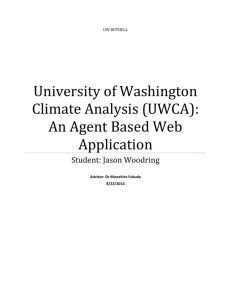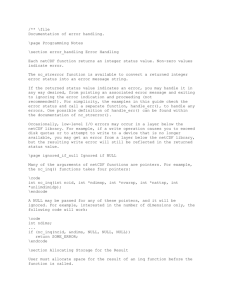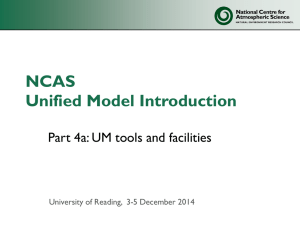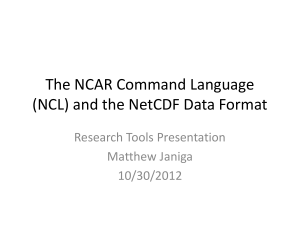netcdf
advertisement
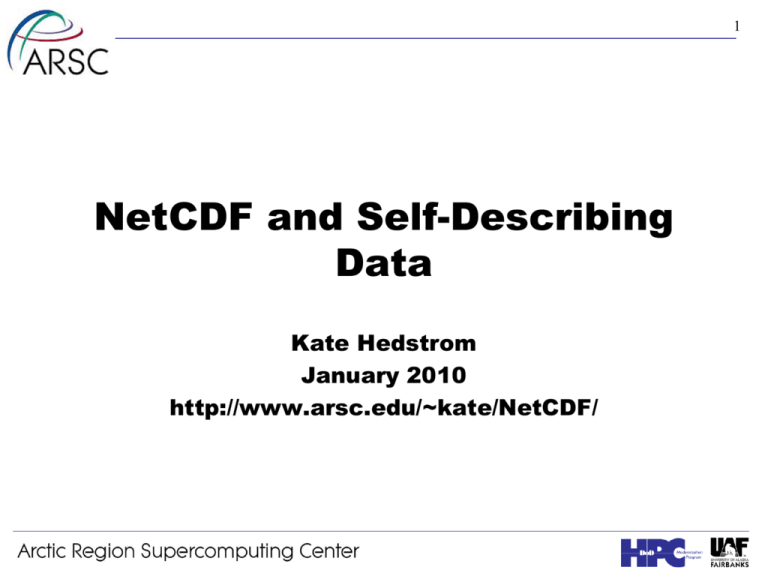
1
NetCDF and Self-Describing
Data
Kate Hedstrom
January 2010
http://www.arsc.edu/~kate/NetCDF/
2
Older File Formats
• ASCII
– Easy to read if small
– Can get large
– Have to know structure to make plots
– Slow to read, write
• Binary
– Smaller, faster than ASCII
– Have to know structure
– Not necessarily portable
– Opaque from outside application
• Example: 9-track tape with ocean data
3
Metadata
• Problems parsing older files has lead to
the development of metadata:
• Data about the data
• File contains data but also
–
–
–
–
–
Name of fields
Dimensions
Type
Units
Special values
• Global attributes, such as title, source,
history, version, etc.
4
XML
• An ASCII format which can
contain all the metadata you want
in the form of a DTD or Schema
• Very cool things can be done,
translating them with XSLT into
other formats
• Way too bulky for our geophysical
model output needs
5
Our File Necessities
•
•
•
•
•
•
Binary for speed
Portable
Metadata
Flexible enough for all our data
Open Source
Can be used from all common
computer languages
6
NetCDF and HDF
• Network Common Data Format (NetCDF)
– http://www.unidata.ucar.edu/packages/netcdf/index.html
– Simpler interface
– Multi-dimensional arrays, de facto standard for model output
for oceans/atmosphere
• Hierarchical Data Format (HDF)
– http://hdf.ncsa.uiuc.edu/
– Parallel I/O, large files
– Collection of file formats
• Scientific Data is like NetCDF
– Used for NASA images
7
NetCDF-3 Library
• Access to all necessary
functionality:
– Open old and new files, close files
– Create dimensions, variables, attributes
– Read and write fields
– Inquire about what is in a file
• Written in C for portability, speed
• Other languages use C interface
8
Languages
• I have used all of these interfaces:
Fortran 77
Fortran 90
C
C++
Perl
Perl Data
Language
Matlab
NCL
• Others: java, ruby, python, GMT, etc.
9
Programs - ncdump
• ASCII dump of all or some of file
• Can ask for just header (-h)
– Dimensions
– Variables and their attributes
– Global attributes
• Can ask for just one variable (-v time)
– Gives the header as well
• Surprisingly useful
10
ncgen
• Inverse of ncdump - creates
NetCDF file from the ASCII dump
• Can be used to modify small files:
– ncdump foo.nc > foo.asc
– Edit foo.asc
– ncgen -o bar.nc foo.asc
• Can be used to generate the C /
Fortran source for creating the file
11
Unstructured Grid Example
12
ncdump
netcdf circle8 {
dimensions:
len_string = 33 ;
len_line = 81 ;
four = 4 ;
time_step = UNLIMITED ; // (0 currently)
num_dim = 3 ;
num_nodes = 12 ;
num_elem = 13 ;
num_el_blk = 1 ;
num_el_in_blk1 = 13 ;
num_nod_per_el1 = 3 ;
num_qa_rec = 1 ;
13
variables:
double time_whole(time_step) ;
int connect1(num_el_in_blk1,
num_nod_per_el1) ;
connect1:elem_type = “TRI3”;
double coord(num_dim, num_nodes) ;
char coor_names(num_dim, len_string) ;
int elem_map(num_elem) ;
int elem_num_map(num_elem) ;
int node_num_map(num_nodes) ;
// global attributes:
:api_version = 3.07f ;
:version = 2.05f ;
:floating_point_word_size = 8 ;
:title = “cubit(circle8.nc):
06/05/2003: 14:10:20” ;
14
data:
connect1 =
2, 1, 10,
1, 9, 10,
9, 8, 10,
8, 7, 11,
7, 6, 11,
6, 5, 11,
5, 4, 12,
4, 3, 12,
3, 2, 10,
10, 8, 11,
11, 5, 12,
12, 3, 10,
12, 10, 11 ;
15
coord =
-600, -459.6, -104,2, 300, 563.8,
563.8, 300, -104.2, -459.6,
-193.1, 208.0, 154.2,
7.3e-14, 385.7, 590.9, 519.6,
205.2, -205.2, -519.6,
-590.9, -385.7, 19.9, -129.8,
238.962035390774,
0, 0, 0, 0, 0, 0, 0, 0, 0, 0, 0, 0 ;
coor_names =
“x”,
“y”,
“z” ;
elem_map = 1, 2, 3, 4, 5, 6, 7, 8, 9, 10,
11, 12, 13;
}
16
Notes on dump
• File contains variable names
• File contains dimensions of all
variables
• Can skip reading unused variables
• Global attributes tell how and
when file was created
• There is an unlimited dimension
– Grows as needed
– Often used for time records
– Only one per file (until version 4)
17
Reading from Fortran
• Declare NetCDF variables, functions
include ‘netcdf.inc’
integer ierr, ncid, varid
real*8 coord(12,3)
• Open the file
ierr = nf_open(“circle8.nc”, NF_READ, ncid)
• Find out the variable id
ierr = nf_inq_varid(ncid, ”coord”, varid)
• Read the variable
ierr = nf_get_var_double(ncid, varid, coord)
18
Reading from Fortran
• Need to declare coord variable with the
right dimensions - can overwrite
memory if declared too small
• Type of Fortran variable must agree
with type in nf_get_var_xxx
• If type in file is different from above
type, library will do conversion
• Arrays in ncdump are C-like:
double coord(3,12)
• Arrays in Fortran are reversed:
real*8 coord(12,3)
19
Fortran 90
•
use netcdf
instead of
include ‘netcdf.inc’
• Knows type:
ierr = nf90_get_var(…)
• Need to tell the compiler how to
find the module file (in include
directory)
20
NCAR Command Language (NCL)
• Scripting language with plotting:
http://www.ncl.ucar.edu/
• Open file and read a variable:
ncid = addfile(“circle8.nc”, “r”)
coord = ncid->coord
• Read with type, dimensions, all attributes
intact:
num_node = dimsizes(coord(0,:))
units = coord@units
• C-like array indexing
21
Cartesian Grid Example
• Use NCL to create NetCDF file and
display its contents
• Design of NetCDF files
– This is the hard part
– Dimensions
– Coordinate variables
– Guidelines for attributes
22
write1.ncl:
begin
ncid = addfile(“rossby1.nc”, “cw”)
x = fspan(-12.0, 12.0, 49)
y = fspan(-8.0, 8.0, 33)
numx = dimsizes(x)
numy = dimsizes(y)
; C order of array dimensions
ubar = new((/numy, numx/), “double”)
vbar = new((/numy, numx/), “double”)
zeta = new((/numy, numx/), “double”)
ubar = …
ncid->ubar = ubar
ncid->vbar = vbar
ncid->zeta = zeta
end
23
netcdf rossby1 {
dimensions:
ncl0 = 33 ;
ncl1 = 49 ;
ncl2 = 33 ;
ncl3 = 49 ;
ncl4 = 33 ;
ncl5 = 49 ;
variables:
double ubar(ncl0, ncl1)
ubar:_FillValue =
double vbar(ncl2, ncl3)
vbar:_FillValue =
double zeta(ncl4, ncl5)
zeta:_FillValue =
}
;
-9999. ;
;
-9999. ;
;
-9999. ;
24
draw1.ncl:
load “$NCARG_ROOT/lib/ncarg/nclex/gsun/gsn_code.ncl
begin
ncid = addfile(“rossby1.nc”, “r”)
ubar = ncid->ubar
wks = gsn_open_wks(“x11”, “draw”)
; set colorfill resource - otherwise get line contours
res = True
res@cnFillOn = True
cmap = …
gsn_define_colormap(wks, cmap)
contour = gsn_contour(wks, ubar, res)
end
25
26
What went right?
• Easily created valid NetCDF file
• Dimensions are right, _FillValue
set automatically
• Can easily read a field from the
file and plot it up
• Half the plotting code is for color
contours - black and white line
contours are even easier
27
What could be better?
• Created six dimensions when two
are needed
• Dimension names are not
meaningful
• _FillValue is the only attribute set
• No global attributes
• Plot aspect ratio is wrong - no
geometry information in file
28
write2.ncl (part):
; dimensions and attributes
ubar!0 = “y”
ubar!1 = “x”
x!0 = “x”
y!0 = “y”
x@units = “meter”
y@units = “meter”
ubar@units = “m/s”
zeta@long_name = “Surface Elevation”
…
ncid->x = x
ncid->y = y
ncid->ubar = ubar
…
29
netcdf rossby2 {
dimensions:
x = 49 ;
y = 33 ;
variables:
float x(x) ;
x:units = “meter” ;
float y(y) ;
y:units = “meter” ;
double ubar(y, x) ;
ubar:units = “m/s” ;
ubar:long_name = “Depth-integrated u-velocity” ;
ubar:_FillValue = -9999. ;
double vbar(y, x) ;
:
double zeta(y, x) ;
zeta:units = “meter” ‘
:
}
30
31
Changes…
Better
– The two dimensions are there - with useful
names
– The two coordinate variables are there
– Plot automatically has title (long_name)
• Still needs fixing:
– Global attributes
– Unlimited dimension for multiple time slices
32
write3.ncl (parts):
; global attributes
fileAtt = True
fileAtt@title = “Class sample”
fileAtt@creation_date = \
systemfunc(“date”)
fileAtt@history = “learning NCL”
fileattdef(ncid, fileAtt)
33
write3.ncl (parts):
; unlimited dimension
filedimdef(ncid, “time”, -1, True)
filevardef(ncid, “time”, “double”, “time”)
time = 0.0
time@units = “sec”
filevarattdef(ncid, “time”, time)
; (/ /) strips attributes from time
ncid->time(0) = (/ time /)
:
dims = (/”time”, “y”, “x” /)
filevardef(ncid, “ubar”, typeof(ubar), dims)
filevarattdef(ncid, “ubar”, ubar)
ncid->ubar(0,:,:) = (/ubar /)
34
netcdf rossby3 {
dimensions:
time = UNLIMITED ; // (1 currently)
x = 49 ;
y = 33 ;
variables:
double time(time) ;
time:units = “sec” ;
float x(x) ;
x:units = “meter” ;
float y(y) ;
y:units = “meter” ;
double ubar(time, y, x) ;
:
// global attributes:
:history = “learning NCL” ;
:creation_date = “Thu Jul 17 15:08:39 AKDT 2003” ;
:title = “Class sample” ;
}
35
36
Summary of Cartesian Example
• We now have our global attributes and
an unlimited dimension
• All this functionality should be
available from any language with a
NetCDF interface
• We managed to get the plot looking
better by setting plot resources,
beyond the subject of this talk
37
Notes on Attributes
• Can be set both for the file and for
each variable
• Not mandatory, but polite
• There are “standard” ones such as
units, long_name, title, etc.
• There are some general and domainspecific guidelines (see NetCDF
manual, web page)
• Can make up and use own:
type=“grid_file” or colorbar=“blues”
38
Matlab Interface
• Available from
http://mexcdf.sourceforge.net
• Three parts:
– mexnc
– snctools
– NetCDF Toolbox
• mexnc is based on the C language
interface
• Other two use mexnc
39
More Matlab
• Try “help snctools” from the
Matlab prompt
• Most commonly used are:
– nc_varget
– nc_varput
– nc_attget
– nc_attput
– nc_dump
40
NetCDF Operators (NCO)
•
•
•
•
•
http://nco.sourceforge.net/
Concatenate files
Difference files
Average files, records
Extract fields or field subsets
– Copy to new file
– Copy to another old file
– Write to ASCII
• Edit attributes, rename variables
41
Evolution
• New HDF5 is incompatible with
older HDF4
– Data structures to accommodate satellite
data, georeferencing, etc.
• Next generation NetCDF-4 is
based on HDF5
– More flexible storage
– Clearer access routines than HDF5
42
NetCDF 4
• NetCDF 4.0 contains a new library
that calls either NetCDF 3
(compatibility mode) or HDF5
• New functions to get at new
functionality, otherwise looks the
same as version 3
• Files created will be old style or new
HDF5 files - all tools need updating
• Still more changes coming in 4.1, 4.2
43
New Features
• Parallel I/O through MPI I/O
• More efficient I/O through chunking,
compression
• Multiple unlimited dimensions
• Compound types
• Will handle files > 2GB by default, not
as special option
• New data types
• Decide at file creation time if it’s in the
new format or not
44
Conclusions
• Converting to NetCDF has been well
worth the trouble
– Portability
– Use of ncdump, nco, etc.
• New interfaces from scripting languages
can make it simple to use
• Converting a new model is easy now that
we’ve seen how to do it once - get the
fields right first, then fix the attributes
• Visualization people will love you!
